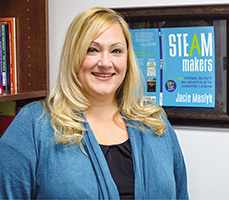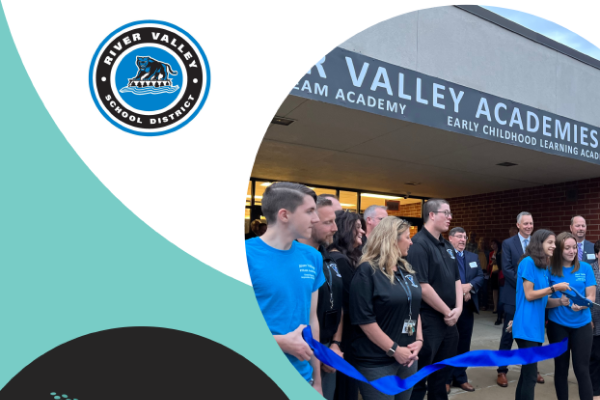Where STEAM is gaining steam
May 01, 2017

Glancing down a long hallway in Hopewell Memorial Junior High School, it’s easy to tell something exciting is brewing.
The 5th-grade students are scattered across the floor in small groups with recyclable materials strewn about. Students are working to build a 3-D portrait of themselves. In nearby classrooms, students in other grades are engaged in a mix of STEAM and maker learning through digital storytelling, building catapults and designing their dream school using a virtual reality tool, CoSpaces.
It’s Global Maker Day in the Hopewell Area School District, and the students are using creativity, collaboration, critical thinking and communication to tackle the same challenge that tens of thousands of students are doing across the world. With a tagline of “create locally and share globally,” this is one way students are using the content they’ve learned in STEAM courses and applying it through hands-on making opportunities.
Permission to Risk
As a former principal, I established a maker space in our elementary school in 2010. In our first year, we incorporated learning strands that focused on robotics, circuitry, engineering and design. The following year, we added an area for woodworking and small hand tools, computers for coding and a workspace for deconstruction and hacking.
The use of new materials and the idea of trying new approaches to learning quickly expanded outside the walls of our maker space and into the classrooms where students and teachers tinkered with making roller coasters, created storyboards for stop-motion animation and explored with sewing.
Now, as an assistant superintendent, I share my passion for hands-on, minds-on learning in a new school district. While I see students ready to take risks, creating underwater remotely operated vehicles, designing Rube Goldberg-like devices and learning to animate using Scratch, their teachers aren’t necessarily convinced.
This is not an uncommon situation in schools today. Opening up one’s classroom to the creative and collaborative imaginations of the students can be a huge leap. Giving permission for teachers to try new things and providing them with ongoing encouragement and support have been the first steps into new learning for students and teachers.
A Shift in Mindset
Education is in the midst of a critical shift from traditional teaching and test preparation to more hands-on, meaningful learning that requires a different skill set in our students. Schools nationwide are embracing STEAM, the thoughtful integration of science, technology, engineering, art and math into their curriculum. The shift from STEM to STEAM connects students to more rigorous and relevant content in creative ways. It offers left-brain thinkers the opportunity to analyze problems and articulate solutions, while it gives right-brain designers the ability to imagine and express their learning through art, music, movement and inventive thinking.
In many schools, where STEAM intersects with the maker movement, powerful learning occurs. As students learn critical content in subjects like math and science, they then can apply what they know in meaningful and often artistic ways through making. This new learning brings with it a new mindset where failures are embraced and perseverance is valued. Students persist through challenges by taking responsible risks, thinking flexibly and innovating, as described in several books about “habits of mind” by Arthur L. Costa and Bena Kallick.
Many school districts are adopting the 16 habits, or attributes humans display when behaving intelligently. In instilling these attributes, educators are acknowledging these dispositions serve as a foundation for our students’ future success. The dispositions are fostered by STEAM learning and the maker movement and help to develop a “growth mindset,” the belief students can grow and learn when faced with new challenges championed by researcher Carol Dweck. As students develop a new mindset toward learning, they can increase their chances for success in college, career and beyond.
Creative Thinking
In their book From STEM to STEAM, David Sousa and Thomas Pilecki reinforce the need to integrate the arts into our educational practices. Their research shows the arts engage the brain, develop cognitive growth, improve long-term memory and promote creativity. By infusing the arts and incorporating a STEAM maker approach, schools can nurture creative thinkers.
As school leaders, one of our goals should be to eliminate barriers between creative and core subjects by creating intentional links from art and music to science and math. STEAM learning and the maker movement provide the opportunity for students to pursue their passions and develop both critical and creative thinking skills.
Sir Ken Robinson, author of Out of Our Minds and Creative Schools and presenter of one of the most-watched TED Talks on education, urges schools to think about a new approach to teaching that promotes creativity with intention. He fears that schools are killing creativity and it is our responsibility to do something about it.
STEAM and the maker movement represent a learning pathway that can fill the creativity void in education and prepare students for an uncertain future where jobs will demand the development of “soft skills.”
Schools are making significant strides in developing future-ready students and addressing the 4 C’s through STEAM and the maker movement. Hands-on learning and design challenges presented through STEAM maker learning not only build creativity, critical thinking, collaboration and communication but also provide a foundation for a growth mindset.
Carrie Rowe, superintendent of the Beaver Area School District in western Pennsylvania, believes that engineering and design are taking hold in her district as teachers are developing sound STEAM pedagogy and a new mindset. “Teachers and administrators are finally asking students to imagine, build, solve, share, fail and try again.”

Maker Schools
The STEAM maker movement is alive and well in the Pittsburgh region, as K-12 schools are providing innovative learning opportunities for students to program robots, engineer roller coasters and create complicated circuits. Students are developing new apps and designing new products for local companies through valuable partnerships established in the region. A thriving network of educators and organizations are working to rethink education in ways that will benefit students.
As school and district leaders explore how STEAM learning and the maker movement fit into their goals, they are considering ways to provide funding, staffing support and resources.
The Brentwood Borough School District has pursured innovative opportunities for its 1,220 students. Superintendent Amy Burch won’t let funding be a barrier to STEAM learning in her district. Educators have earned numerous grants and initiated community-based fundraising to bring new learning opportunities to students.
A new learning space at the elementary level in Brentwood combines robotics and digital animation with 4th graders using new content to build model smart homes. At the middle school, student projects include creating bobbleheads using 3-D design software, prototyping toys to donate to local organizations and designing jewelry using 3-D printers and routers.
The district is one of many in Allegheny County, Pa., taking advantage of the STEAM Lending Library at the Allegheny Intermediate Unit where educators can borrow Hummingbird Robotics kits, littleBits and Osmos to introduce students to STEAM content in fun and creative ways.
Network Backing
In Beaver County, located northwest of Pittsburgh, school districts are just beginning their STEAM maker journey. Several districts collaborated to create the Beaver County Innovation and Learning Consortium. Beaver Area, Hopewell Area and Rochester Area school districts are working with the Beaver Valley Intermediate Unit to support new instructional practices that support innovation and establish maker spaces in their schools. The group, led by superintendents and assistant superintendents, established a network of learners that will help their districts overcome potential obstacles as they create a new model for cross-district partnerships.
The consortium is creating a model of shared professional development across organizations and working together to bring new learning to teachers and students in their county. Rowe, one of the network’s founders, believes student learning has changed significantly. “Everyone learning the same content at the same time and assessing through paper-and-pencil test is insufficient,” she says.
Beyond Pennsylvania, schools are implementing STEAM and making in new ways. When faced with a lack of space but a yearning for new opportunities for students, Norwood Elementary School in Baltimore County, Md., took an inventive approach. Assistant principal Candice Stafford worked with her principal, Pat Goldys, to convert an aging school bus into the Norwood Project STREAM Bus (the R stands for reading). The county provided the school with money to retrofit the bus and equip it with tools and materials to make the learning mobile. Administrators and educators from the school take the bus out once a week and provide STEAM-related workshops in three different community locations. Now Norwood can serve over 500 students in their school as well as countless families in their community.
Ready to Innovate
Innovator and author Gary Stager calls the shift to making “the perfect storm of new technological materials, expanded opportunities, learning through firsthand experience and the basic human impulse to create.”
When students are using knowledge to make something, learning becomes personalized. When aligned to STEAM content, schools can design experiences that engage students in deeper learning. Schools are making strides in fostering creativity, critical thinking, collaboration and communication skills to develop future-ready students who are ready to innovate.
Author
Additional Resources
Author Jacie Maslyk recommends these informational resources relating to STEAM in K-12 education.
- The Big Book of Makerspace Projects by Aaron Graves and Colleen Graves is full of hands-on projects for teachers and librarians to infuse creativity.
- Invent to Learn by Sylvia Libow Martinez and Gary Stager is a practical resource on STEAM learning.
- Launch by A.J. Juliani and John Spencer provides a classroom framework for educators who want to implement making in the classroom.
- Renovated Learning is a web resource that includes inspiring blogs, book reviews and practical advice from a maker and librarian.
- Worlds of Learning is a rich website that includes numerous resources and links to professional learning courses for educators.
Advertisement
Advertisement
Advertisement
Advertisement



